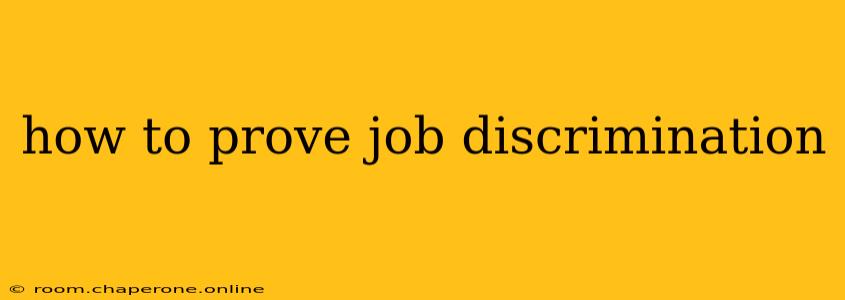Job discrimination is illegal and devastating. If you believe you've been a victim, gathering strong evidence is crucial to building a successful case. This guide outlines the steps involved in proving job discrimination, covering various forms of discrimination and legal strategies.
Understanding Different Types of Job Discrimination
Before diving into the proof process, it's essential to understand the various types of discrimination protected by law. These include, but aren't limited to:
- Race and Color Discrimination: Treating individuals differently based on their race or skin color.
- National Origin Discrimination: Discrimination based on an individual's country of origin, ethnicity, or accent.
- Religion Discrimination: Discriminatory actions due to an individual's religious beliefs or practices.
- Sex Discrimination: This includes gender discrimination, pregnancy discrimination, and sexual harassment.
- Age Discrimination: Discrimination against individuals aged 40 and older.
- Disability Discrimination: Discriminatory treatment of individuals with disabilities, both visible and invisible.
- Genetic Information Discrimination: Discrimination based on an individual's genetic information.
Gathering Evidence to Prove Job Discrimination
Building a strong case requires meticulous evidence collection. Here's a breakdown of crucial evidence types:
1. Direct Evidence:
This is the strongest form of evidence, consisting of explicit statements or actions demonstrating discriminatory intent. Examples include:
- Email correspondence: Emails containing discriminatory remarks from employers or colleagues.
- Written memos or documents: Internal documents showing discriminatory policies or decisions.
- Witness testimonies: Statements from colleagues or supervisors who witnessed discriminatory acts.
- Recorded conversations: Audio or video recordings that capture discriminatory statements or actions (ensure you comply with all relevant recording laws).
2. Circumstantial Evidence:
When direct evidence is lacking, circumstantial evidence can still build a compelling case. This type of evidence relies on building a pattern of discriminatory behavior:
- Statistical evidence: Demonstrating disparities in hiring, promotion, or compensation based on protected characteristics.
- Comparable cases: Showing that similarly qualified individuals from non-protected groups were treated more favorably.
- Pattern of behavior: Demonstrating a consistent pattern of discriminatory actions towards individuals with specific protected characteristics.
- Missing documentation: Absence of documentation that should normally exist for similar situations with employees from non-protected groups.
3. Documentation is Key:
Meticulously document every interaction related to the potential discrimination. This includes:
- Job application materials: Keep copies of your resume, cover letter, and application materials.
- Interview notes: Record details of your interviews, including who was involved, what was discussed, and any unusual or concerning comments.
- Performance reviews: Maintain copies of your performance reviews, noting any discrepancies or unfair assessments.
- Communication records: Save all emails, text messages, and letters related to your employment.
- Dates and times: Precisely document dates, times, and locations of events.
Legal Strategies and Next Steps
Once you've gathered substantial evidence, you should consult with an employment lawyer. They can advise you on the best course of action, which might include:
- Filing a complaint with the Equal Employment Opportunity Commission (EEOC) or a similar agency: This is a crucial step in pursuing legal action.
- Negotiating a settlement with your employer: In some cases, a settlement can resolve the issue outside of court.
- Filing a lawsuit: If a settlement cannot be reached, a lawsuit may be necessary.
Preventing Future Discrimination
Proactive steps can help minimize the risk of future discrimination:
- Know your rights: Understand the laws protecting against discrimination in your workplace.
- Document everything: Maintain detailed records of your work performance and interactions with colleagues and supervisors.
- Network professionally: Build relationships with colleagues and mentors who can support you.
- Seek legal counsel promptly: Don't hesitate to consult with an attorney if you suspect discrimination.
This guide provides a general overview; specific legal requirements vary by jurisdiction. It's crucial to consult with a qualified employment lawyer for personalized advice based on your specific circumstances. They can help you navigate the complexities of proving job discrimination and pursue the most effective legal strategy.

